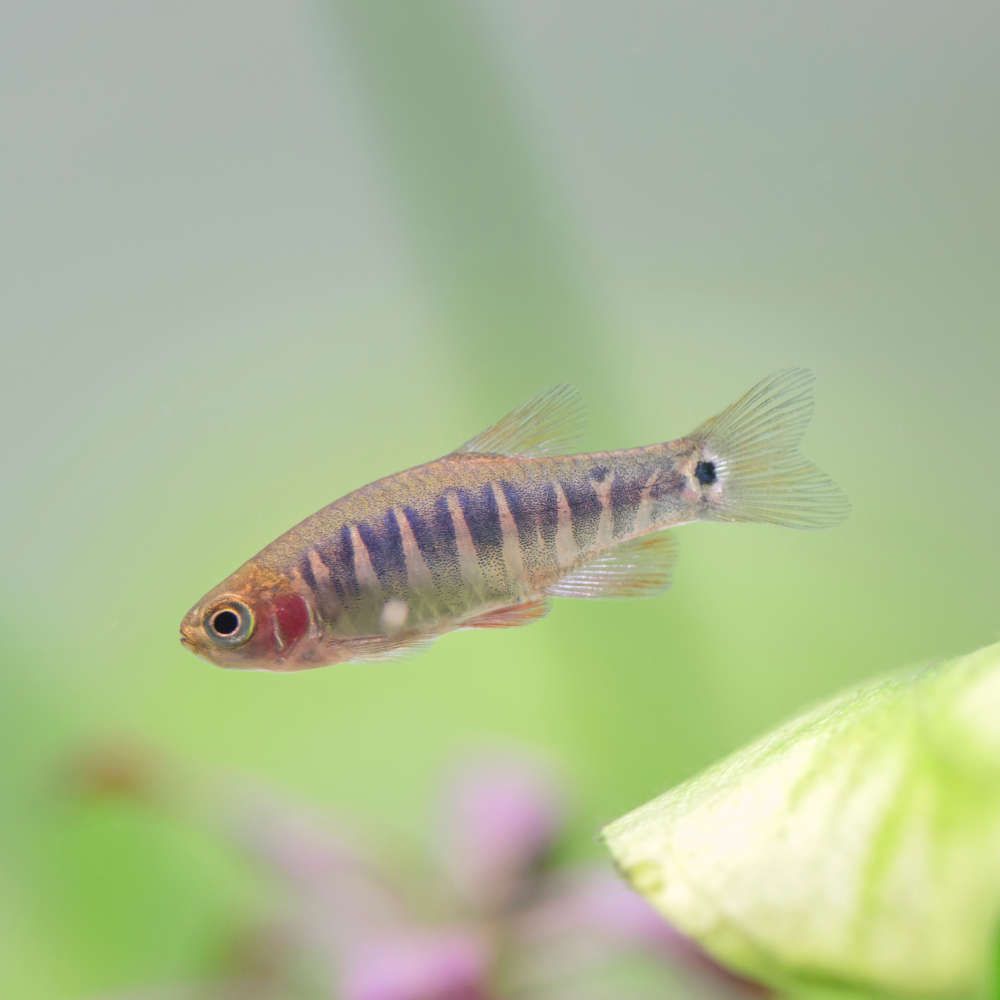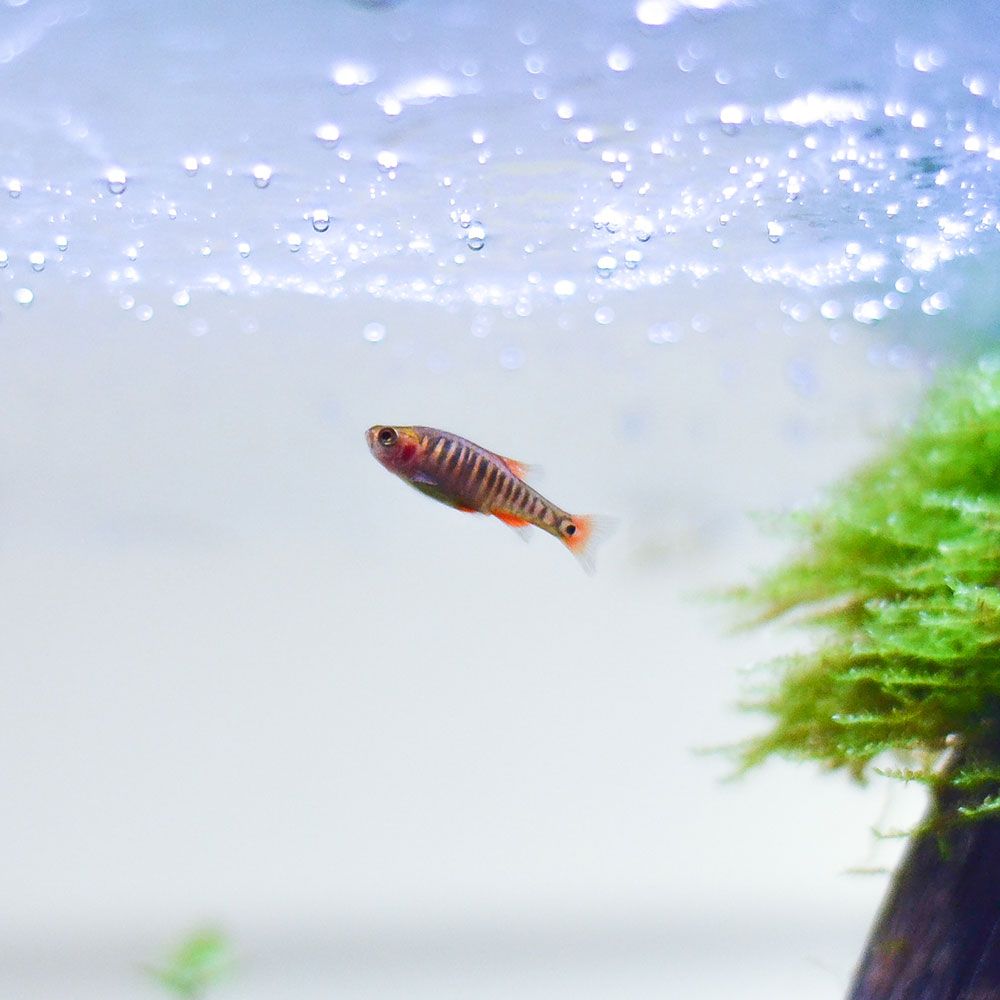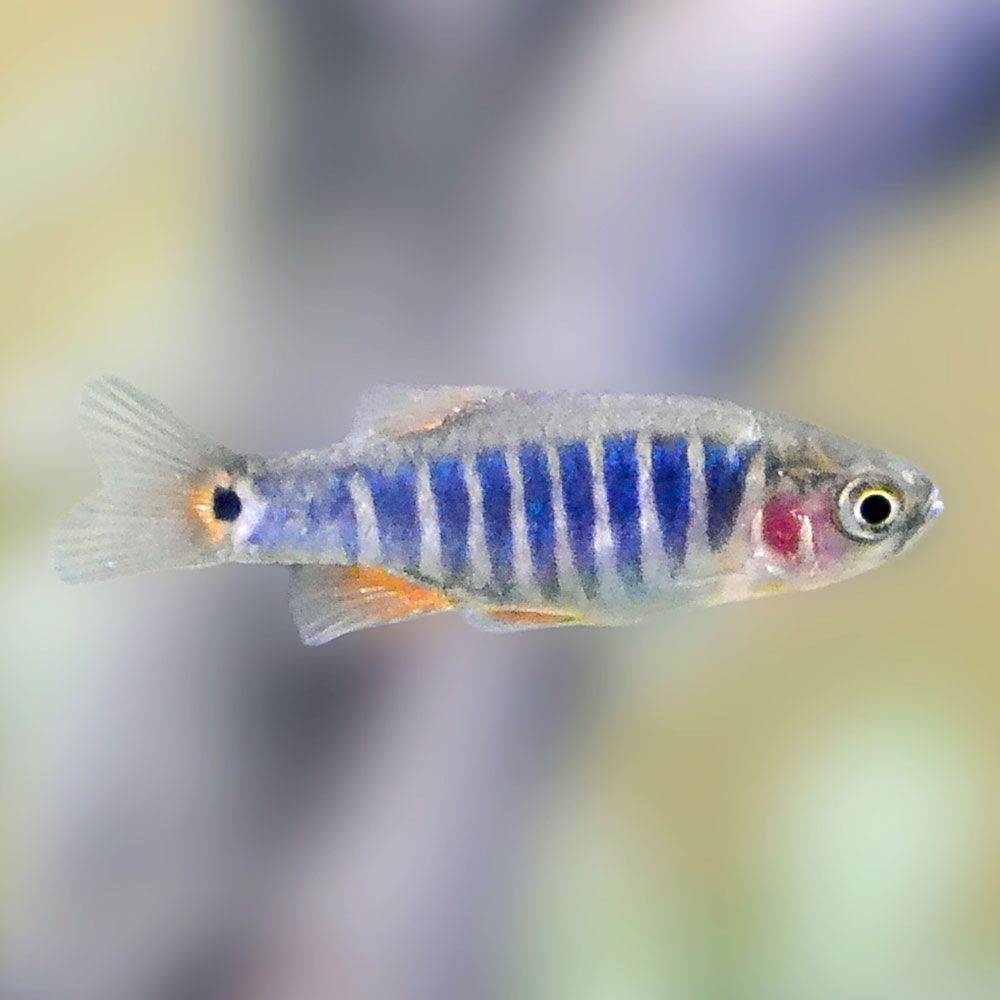Being gluttonous for protein snacks, this tiny fin buddy can also make great friends with other peaceful species.
So, if you are curious about this pretty fish, keep reading!
What is Emerald Dwarf Rasbora?
The emerald dwarf rasbora is a lovely freshwater fish that stands out for its unique beauty. The fish is easy to raise in your home aquarium and perfect for beginners.
| Origin | Lake Inle of Shan State in eastern Myanmar |
| Order | Cypriniformes |
| Family | Cyprinidae |
| Scientific Name | Danio erythromicron |
| Common Names | Danio esmeralda, Emerald dwarf rasbora, Rasbora esmeralda, Emerald dwarf danio, Burmese zebra rasbora, Thick band purple zebra danio, Cross-banded dwarf rasbora, Crossbanded rasbora. |
| IUCN Red List Status | Endangered |
| Appearance | Pinkish skin with broad emerald or blue stripes, big eyes, spots at the base of caudal fin |
| Size | Usually 3 cm (1.2 in), Max 4 cm (1.5 in) |
| Lifespan | 3-5 years |
| Temperament | Peaceful, active, males can be aggressive toward each other |
| Tank Level | Middle to bottom dweller |
| Water Temperature | 70-77 °F (21-25 °C) |
| pH Level | 7-7.5 |
| Water Hardness | Upto 10 dGH |
| Care Level | Beginner |
| Minimum Tank Size | 25 gallons for a group of 10 |
| Tank Environment | Densely vegetated, decorated with hiding spaces, dark substrate |
| Diet | Omnivorous, preference for protein-rich food |
| Tank Mates | Own group, other similar-sized peaceful fish |
What is the Natural Habitat of Emerald Dwarf Rasbora?
Naturally, emerald dwarf rasbora is found in Lake Inle of Shan State in eastern Myanmar and the catchment of Lake Inle near Loi Kaw in Kayah State. The water in these areas has seriously dense vegetation, also called “floating islands,” where the fish is often caught.
The fish is circulated to other places because of the ornamental fish hobby. But it hasn’t turned into an invasive species.
According to The IUCN Red List of Threatened Species assessment of 2011, this fish was marked Endangered.
Which family does Emerald Dwarf Rasbora belong?
This fish belongs to the Cyprinidae family under the Cypriniformes order and is scientifically known as Danio erythromicron.
However, the fish is popular worldwide by a variety of names, like danio esmeralda, emerald dwarf rasbora, rasbora esmeralda, emerald dwarf danio, Burmese zebra rasbora, thick band purple zebra danio, cross-banded dwarf rasbora, and crossbanded rasbora.
Fun Fact: The word ‘Erythro’ in this fish’s scientific name is Greek for ‘red’ and “micro” means small.
How does Emerald Dwarf Rasbora look?

The emerald dwarf rasbora has a bluish hue on coral pink skin and glowing emerald stripes down the sides.
What is the Size of Emerald Dwarf Rasbora?
This rasbora is a “dwarf” species, and the adult grows up to 3 cm (1.2 in). The maximum reported size for this fish is 4 cm (1.5 in).
What is the Color of Emerald Dwarf Rasbora?
Its pelvic and anal fins are reddish. The fish has a black spot at the base of its caudal fin. The spot mimics its eyes so that predators attacking from the back are tricked into believing that the fish is facing them.
The gold-pink shades on its head to the dorsal area give the coloring of this fish another dimension.
The color of this fish depends on its environment, as it becomes brighter and more colorful when it is safe and healthy in soft water.
The juvenile appears beige or translucent.
What are the Features of Emerald Dwarf Rasbora?
This fish has a long, thin body with a flat head that has large shining eyes on either side of it. It has a set of translucent scales around the gill plate.
What is the difference between a male and a female Emerald Dwarf Rasbora?
There are noticeable differences between the male and the female of this species. But because of its small size, beginner aquarists may find it a little difficult to tell.
The male is a little smaller and has distinct red fins. It also has brighter coloration and more defined emerald stripes as compared to its female counterpart.
The female fish is larger and has a rounder abdominal area. It lacks the bright coloration of the male. Its fins are more transparent and less pigmented.
At its juvenile stage, both sexes look the same.
What is the behavior of Emerald Dwarf Rasbora in a tank?
This fish exhibits peaceful behavior. There have been no reports of territorial behavior in this species. It is not aggressive with other fish, but some fin nipping might be seen within its kind.
It is a shoaling fish and gets more boisterous as the number of members of its kind increases. So, in larger groups, it is bold and has a brighter color.
But, alone, it is quite shy and might hide when people pass by its tank. Yet, it is very curious and will explore every corner of its tank.
The males can show rivalry if enough females are not present in the tank. But, in my experience, no serious injuries are seen after these fights.
How long do Emerald Dwarf Rasbora live?
The emerald dwarf rasbora lives for at least 3-5 years. Of course, this holds true given that its water conditions are pristine and it is very well cared for.
Author’s Note: This fish will exhibit more interesting behavior if it is kept with a lot of members of its own kind.
How to take care of Emerald Dwarf Rasbora?

Now, if you can’t wait to bring this fish home, let us tell you how to care for it!
What is the Tank Size for Emerald Dwarf Rasbora?
The emerald dwarf rasbora prefers to live with big groups of its own kind, so you should keep at least 10 to 15 members together.
A 25-gallon tank is enough for a group of 10 to live without any problems.
Increase the tank size to 30-40 gallons if you want to keep a bigger shoal of fish.
What is the Water Chemistry of the tank for Emerald Dwarf Rasbora?
Tiny species like this rasbora need special water conditions to have a long life. So be careful about meeting these requirements to give your fish good living conditions.
- pH Levels: 7-7.5
- Water Temperature: 70-77 °F ( 21-25 °C)
- Water Hardness: Up to 10 dGH
- Ammonia: 0 ppm
- Nitrite: 0 ppm
- Nitrate: Below 20 ppm
What is the Tank Environment for Emerald Dwarf Rasbora?
To keep your rasbora happy, you must give it a comfortable home that mimics its natural habitat. These are a few things that you should include in your aquarium setup.
Which Substrate should you use for Emerald Dwarf Rasbora?
Use a dark substrate, as this will contrast well with the fish’s color and remind the fish of the loamy bottom of its natural habitat. Fine sand should be used instead of gravel to ensure the safety of this fish.
Which Plants should you use for Emerald Dwarf Rasbora?
The emerald dwarf rasboras come from a heavily vegetated lake. So, it prefers a lot of plants in its tank. Place several floating plants in its tank.
What type of Lighting is required for Emerald Dwarf Rasbora?
The fish does not require any particular lighting. Any kind of lighting can add to the beauty of this fish’s colors. So, pay attention to the lighting requirements for the live plants you have placed in the tank.
What Décor is required for Emerald Dwarf Rasbora?
Add a lot of decoration that will provide suitable hiding places for the fish, like rocks, caves, and fake driftwood.
But avoid any natural driftwood or leaf debris. These might release tannins, and tannin-stained water is not to its liking.
Which type of Filtration is needed for Emerald Dwarf Rasbora?
As emerald dwarf rasbora is kept in large groups, the waste produced is a lot. So to filter out all the ammonia and nitrate, you will need strong filtration. Place a hang-on filter that is 4-5 times the volume of the tank to keep the water clean.
What should be the Water Flow Rate for Emerald Dwarf Rasbora?
The natural habitat of the emerald dwarf rasboras has almost a standstill water flow. So, to mimic the same, keep the water flow minimal in your tank.
Fish Care Tip: To maintain the best water conditions for your rasbora, keep changing 20% to 30% of water in your tank each month.
What do Emerald Dwarf Rasbora eat?
The emerald dwarf rasbora is omnivorous and relatively easy to feed. But the food should be small enough to fit its mouth.
A variety of food will meet its nutritional needs, and high protein content will enhance its coloration. To give you a kickstart, here are some recommendations that you can choose from.
- Brine shrimps
- Mosquito larvae
- Daphnia
- Microworms
- Bloodworms
- Micropellets
- Flake food
- Algae wafers
- Dry food
- Freeze-dried food
- Tubiflex
- Artemia
To avoid overfeeding the fish, break up the total intake into two or three small feedings throughout the day.
What are the Tank Mates for Emerald Dwarf Rasbora?
As emerald dwarf rasbora is a shoaling fish, it likes to swim in groups for a while and then go off exploring on its own. So, before you place other tank mates, add a group of 10-15 of them.
There should be a balanced ratio of male to female emerald dwarf rasboras. At least ensure that the number of males does not exceed females. Otherwise, the males show rivalry and might become aggressive.
But it is a peaceful species that adjusts well with other small, peaceful fishes. So, to build a community aquarium, consider some of these as your rasboras’ tankmates:
- Small barbs
- Devarios
- Freshwater snails
- Sawbwa barbs
- Red dwarf rasboras
- Lake Inle danios
- Celestial pearl danios
- Glowlight danios
- Cherry shrimps
- Neon tetras
Which Tank Mates to Avoid for Emerald Dwarf Rasbora?
To keep your pet emerald dwarf rasbora safe in its own home, you must avoid the following types of species:
- Larger fish: The rasbora might become its prey
- More aggressive fish: The rasbora will be intimidated and stop being active. Aggressive fish might also compete with them for food.
- Tropical fish or those requiring warm water: This fish prefers cooler water conditions, so warm water species cannot be kept in the same tank
Some fish that you must never house with emerald dwarf fish are:
- Goldfish
- Oscars
- Cichlids
- Crabs
- Barbs
What are the Common Diseases associated with Emerald Dwarf Rasbora?
The emerald dwarf rasbora is not too sensitive, but some diseases may affect it periodically. Let us tell you all about it.
| Disease Name | Causes | Symptoms | Treatment |
|---|---|---|---|
| Freshwater Ich | Parasitic infection | White spots on the skin, loss of appetite, not schooling, rapid breathing | Add aquarium salt, copper sulfate, elevate aquarium temperature |
| Fin Rot | Bacterial infection, poor water quality, contact with sick fish | Loss of color, ripping fins, loss of appetite, and lethargy | Aquarium salt and antibiotics, water quality enhancement, remove harmful objects |
| Columnaris | Bacterial infection | White or grey patches, lethargy, loss of appetite, fin fraying | Improve water quality, administer antibiotics, reduce stress |
| Swim Bladder Disease | Bacterial infection | Trouble in stability, laying on its side | Feed daphnia and shelled peas, treat with antibiotics |
| Skin Flukes | Parasitic infection | Difficulty breathing | Lower salinity of water, medication |
Note: Remove all uneaten food to prevent bacteria buildup in the water.
How to Breed Emerald Dwarf Rasbora in aquarium?
It can be a little tricky to breed emerald dwarf rasboras, but with proper measures in place, you can successfully do this. Let us tell you how to go about this and prevent fry loss.
Conditioning & Pair Obtaining
To condition the fish, feed them various high-quality foods such as live daphnia, bloodworms, and frozen brine shrimp.
Increase the hours you keep the aquarium lighted to trigger breeding behavior.
To identify breeding behavior in males, check for brighter colors, chasing, and doing courtship dances. Females become plump when they are gravid.
When a pair shows breeding behavior, separate them into a breeding tank.
What is the Tank Preparation for breeding Emerald Dwarf Rasbora?
For a pair of emerald dwarf rasboras, set up a 10-gallon tank with a sponge filter for oxygenation.
The tank should be well-vegetated with plenty of hiding spaces. A substrate of java moss or spawning mops will be suitable for the tank.
Additionally, make sure to maintain the following parameters
- pH Levels: 6-7
- Water Temperature: 25-28°C (77-82°F)
- Water Hardness: Up to 8 dGH
What is the Mating Process of Emerald Dwarf Rasbora?
The female fish is an egg scatterer. So when ready, she will scatter around 30 eggs, and the male will fertilize the scattered eggs. The species is a continual spawner, so the female lays several eggs each day.
Fry Separation
The fish provides no parental guidance. Instead, the parent fish might eat its own eggs. So, you must separate the eggs into a hatching tank as soon as possible.
When do the Emerald Dwarf Rasbora eggs hatch?
It might depend a little on temperature, but the eggs will hatch in about 72 hours. Within 3-4 more days, the fry will become free swimmers. Until then, the fry absorbs nutrition from its egg sac.
For healthy development, feed the fry small amounts of baby brine shrimp, nauplii, infusoria, or commercial fry food multiple times a day.
As they grow, feed them infusoria, cyclops, liquid fry food, and paramecium.
Fry Tank Maintenance
The water in the fry tank should be partially changed daily, and any excess food particles should be siphoned out. An air stone can be added to keep the water aerated.
Quick Tip: Snails that are disease free can be added to the fry tank to help clear excess food.
How to buy Emerald Dwarf Rasbora?
- Buy a group of them from the same tank of a shop to promote easier friendly bonds.
- Choose specimens that are active.
A word from FishInAquarium
Emerald dwarf rasbora is a docile fish, popular both among beginners and experts. Its magical colors add a splash of magic to your tank.
In groups, its active nature will add life to your aquarium. In fact, it can be the perfect antidote to your boredom.
So, now that you have all your questions answered, make sure to share this with other fish enthusiasts. And, if you have any doubts left whatsoever, definitely drop a mail, and we will sort it all out!


